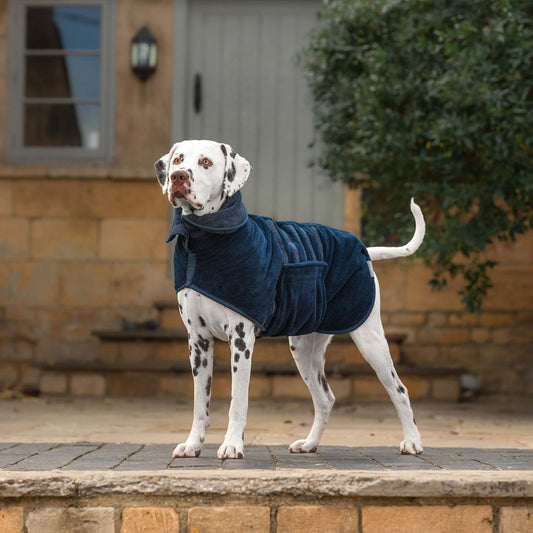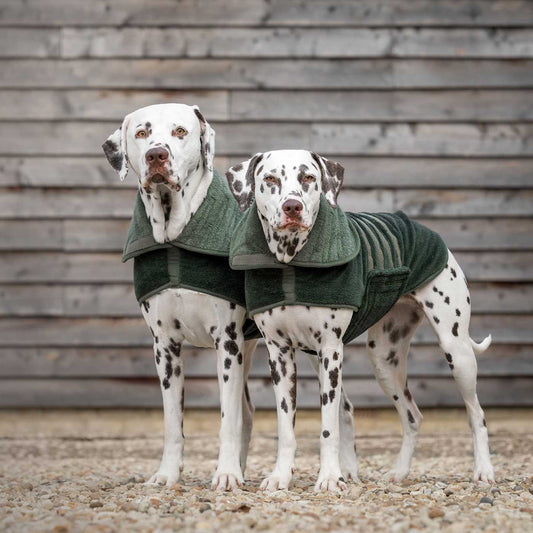Here in the UK we're officially in a cold snap, with forecasters predicting a blanket of 'freezing fog' to cover most of the UK. Snow and other winter weather can look pretty; no one can doubt the beauty of a hoar frost or a landscape dusted in white. But it’s also extremely cold and slippery at times, and it can bring some hazards and challenges for pet owners. Here we give our top tips for cat and dog owners to help you and your four-legged friends get through the rest of the winter season safely and in good health.
Top 10 At Home Winter Weather Tips
- Keep your pets active indoors - If you get an extremely cold snap, you may find dog walks are reduced to the bare minimum and cats won’t go out as much. It’s really important to keep your pets active indoors on these occasions. Toys and interactive games will help to keep both their minds and bodies active. Our article, ‘Things to do With Your Dog at Home’ has some great ideas if you’re struggling to find things to keep them interested. You could also browse our toys for cats and toys for dogs where you can find all kinds of fun activities for them to keep them entertained in the house. We love a snuffle mat for dogs to keep them busy and the catit circuits are great for keeping your cats active!
- Consider keeping your outdoor cat inside - Many cats, even those that usually go outdoors, will choose to stay in the warm during cold weather snaps, especially snowy conditions. But if you have an outdoor cat that still likes to roam outside, even when it gets frosty, make sure they have places that they can easily get to in terms of shelter, food and water. If in doubt, we’d suggest keeping your cat indoors, even if it does make them a bit grumpy. Provide them with plenty of stimulation in the house such as interactive toys and a good cat scratch post or tree. Don't forget to provide them with a cat litter tray in the house. Many think it unnecessary for an outdoor cat to have a litter tray, but when adverse weather keeps your feline indoors, they'll need somewhere to toilet.
- Keep an eye on your pet's diet and food intake - If you do find yourselves stuck indoors more, you may want to keep an eye on your cat's or dog’s diet and make adjustments if needed. Less activity can easily lead to weight gain, so consider reducing portion size if you think it necessary.
- Stock up on balms and nourishing products - Dogs, just like humans, can experience dry skin and hair in the colder months. Exposure to adverse weather and low temperatures can leave your dog with cracked skin and a dull coat. Stock up on some nourishing grooming products and help keep their skin and coat in tip-top conditions. Natural paw and nose balms will keep flaky skin at bay whilst there are a number of sensitive, nourishing shampoos that you could choose from to keep their coat looking shiny. Remember to brush them daily to distribute the natural oils in their coat, which will really help too.
- Jumpers for tiny dogs, dogs with fine hair and senior dogs - In winter, it’s all about keeping our little ones as warm and cosy as possible. Tiny dogs, those with short coats and older dogs sometimes need help to retain their body heat, even indoors. A dog jumper isn’t just a style choice, but can be a really practical option for those dogs who find it hard to keep warm on their own in the coldest months. You may want to layer a coat over the top if you take them outside.
- Groom with caution! - Don’t over groom dogs with thicker or longer hair to the point that your dog can’t keep warm. Whilst it’s really important to keep a good dog grooming regime going through winter, it’s also essential that you don’t rid them of their natural insulation. Keeping their coats brushed and tangle free is an absolute must to deter matts from developing. You may think that a good trim will help too, so that it doesn’t gather as much dirt, but try not to over trim as their winter coat is there to keep them warm.
- Prepare more than one bed around the house - There’s nothing cosier than an extra blanket in winter and our pets can benefit from them too! You may want to consider swapping out your dog’s or cat’s regular bed for a faux fur or sherpa option, or maybe consider adding a cosy blanket. It’s important to give your pets sleeping options; a couple of beds with varying layers or textures so that they can move if they start to get too hot or too cold.
- Prevent poisoning and protect the whole household - Antifreeze is widely used in winter, but it is crucial that you take care with it around animals. Make sure that any spills or dribbles are wiped clean and never leave the bottle where your dog or cat could get to it as it is seriously toxic to pets; even causing death in some cases. Make sure this and any other toxic products are kept locked away out of their reach and ensure you clean up after use.
- Check your car in the morning - Cats that do venture out in the Winter may well find your warm car welcoming and find shelter in it. They can easily climb up into wheels to take shelter from cold, frost or snow, and could be severely injured or even killed if you start the car with them in it. When you go out to your car, bang the bonnet before you get in as a precaution.
- Check on your pets with joint pain - Just like us, pets with joint pain can often suffer more during cold weather. Check to see if their movements seem different to normal, it may be worth checking with your vet if they have any advice on joint supplements that may help keep them pain-free during this cold snap
Winter Dog Walking Tips
- Wrap up on dog walks - The most important thing when the weather becomes colder is to ensure that your dog is kept warm. This goes for indoors and outdoors. It’s important that dogs get some fresh air, especially if the bad weather is extended. You can’t keep them indoors forever! Keep walks short and ensure they have a suitable dog coat; one that fits well and suits the climate.
- Check for snow between their toes - Snow and ice is uncomfortably cold for humans and pets alike. Snow can turn to ice quite quickly in the coldest conditions which can get caught in your dog’s paws and cause pain and soreness. After a dog walk always check your pet’s paws and dry them down thoroughly to help keep the skin healthy.
- Beware of snow salt and grit - Another reason to check your dog’s paws is for snow salt, and grit used to deter frost on pavements and roads. This can be toxic to dogs and cause inflammation and soreness to paw pads. Always wipe down your dog’s paws immediately after a winter walk. If your dog is particularly sensitive then consider some snow booties to help protect them on walks.
- Be safe in low light - Winter brings with it shorter daylight hours. Even if the weather is fine, you may find that you end up walking in low light levels. Ensure you are visible with fluorescent colours and reflectors. We have a number of safety accessories that may be suitable in our walking accessories collection as well as a range of dog coats that have reflector panels. We particularly love the Orbiloc Dog Safety Light at this time of year as it can be attached to any of your accessories including your lead, collar or dog harness.
Winter can seem like a long season, with short daylight hours and adverse weather, but you and your pets can still enjoy and make the most of it. Indoor games and activities can be really fun for you both and don't forget how pretty winter can be too.
It won't be long before Spring makes an appearance and the landscape begins to bloom again. Until then, enjoy some cuddles on the sofa with your cats and dogs and try to stay happy and safe!

































































































